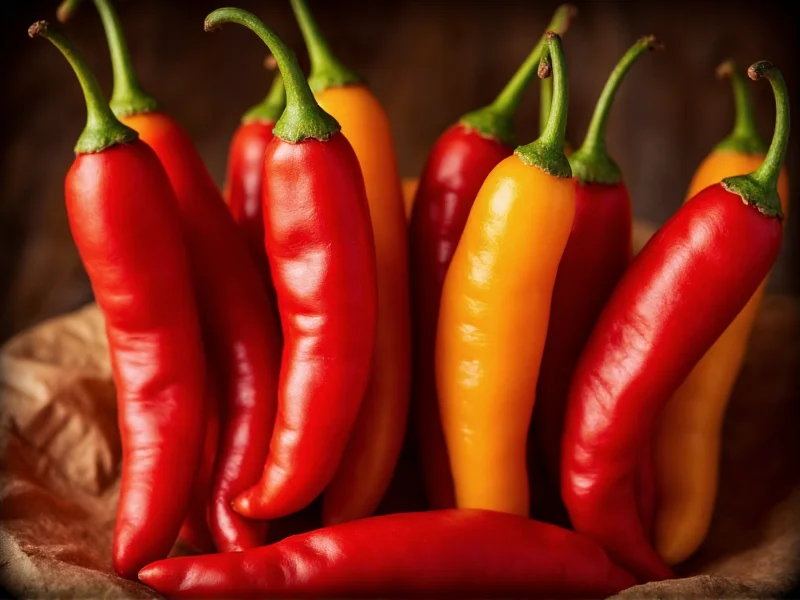Understanding chili heat levels is essential for both culinary enthusiasts and casual cooks. The Scoville scale, developed by pharmacist Wilbur Scoville in 1912, remains the definitive method for measuring the pungency of chili peppers. This measurement reflects the concentration of capsaicinoids, with capsaicin being the primary compound responsible for the burning sensation we perceive as "heat."
The Science Behind Chili Heat Perception
When you consume chili peppers, capsaicin binds to TRPV1 receptors in your mouth and throat, triggering a neurological response that your brain interprets as heat. This biological mechanism explains why drinking water provides little relief from intense heat—capsaicin is hydrophobic, meaning it doesn't dissolve in water. Dairy products containing casein, however, can effectively break down capsaicin molecules and provide relief.
Modern laboratories now use high-performance liquid chromatography (HPLC) to precisely measure capsaicinoid concentrations, converting these measurements to Scoville Heat Units for consumer understanding. This scientific approach has replaced Scoville's original subjective taste-test method, ensuring more accurate and consistent heat level assessments across different pepper varieties.
Comprehensive Chili Pepper Heat Scale Reference
| Pepper Variety | Scoville Heat Units (SHU) | Heat Level Classification | Common Culinary Uses |
|---|---|---|---|
| Bell Pepper | 0 SHU | Mild | Salads, stuffed peppers, raw consumption |
| Pepperoncini | 100-500 SHU | Mild | Greek salads, sandwiches, pickling |
| Jalapeño | 2,500-8,000 SHU | Medium | Salsas, nachos, poppers, pickled jalapeños |
| Habanero | 100,000-350,000 SHU | Very Hot | Hot sauces, Caribbean cuisine, marinades |
| Ghost Pepper (Bhut Jolokia) | 800,000-1,041,427 SHU | Extremely Hot | Competitive eating, extreme hot sauces, military applications |
| Carolina Reaper | 1,400,000-2,200,000+ SHU | Ultra Hot | Specialty hot sauces, novelty foods, research applications |
This scoville scale chart for chili peppers demonstrates the enormous range in heat intensity across different varieties. When exploring mild to hot chili pepper varieties, it's important to understand that heat levels can vary significantly within the same pepper type due to growing conditions, soil composition, and climate factors. For example, a jalapeño grown in optimal conditions might register at the lower end of its SHU range, while stressors like drought can dramatically increase capsaicin production.
Practical Applications in Cooking and Food Preparation
Understanding how to measure chili pepper heat is crucial for successful culinary applications. When substituting peppers in recipes, consider both heat level and flavor profile. While habaneros and Scotch bonnets share similar SHU ranges, they offer distinctly different flavor notes—habaneros provide a fruity, citrusy flavor while Scotch bonnets have a more complex, smoky-sweet profile.
When handling extremely hot peppers, always wear gloves and avoid touching your face. The capsaicin oils can transfer to sensitive areas and cause significant discomfort. If you've overestimated your tolerance in a dish, remember that dairy products like yogurt or sour cream can help neutralize the heat, while acidic components like lime juice can balance the flavor profile without reducing actual heat intensity.
Factors Influencing Perceived Heat Levels
Several elements affect how we experience chili heat beyond the objective SHU measurement. Individual tolerance varies significantly based on genetics and exposure history—regular consumers of spicy foods often develop higher tolerance through repeated exposure. The food matrix also matters; fat content in dishes can bind capsaicin, making high-heat peppers more manageable in creamy sauces compared to vinegary preparations.
Interestingly, the same pepper can register different heat levels depending on where it's grown. Environmental stressors like inconsistent watering, temperature fluctuations, and soil nutrient levels can dramatically increase capsaicin production as the plant's defense mechanism. This explains why understanding scoville heat units requires consideration of more than just the pepper variety—it's a complex interplay of genetics and environment.
Safety Considerations for Extreme Heat Peppers
When working with super-hot peppers like the Carolina Reaper or Trinidad Moruga Scorpion, proper safety protocols are essential. Always use nitrile gloves (latex provides insufficient protection), work in well-ventilated areas, and avoid contact with eyes or skin. Consider using specialized tools like dedicated cutting boards and utensils that won't transfer capsaicin to other foods.
If accidental exposure occurs, immediately wash the affected area with soap and cold water—avoid hot water as it can open pores and increase absorption. For severe reactions, apply milk or yogurt to the affected area. Never attempt to consume record-breaking peppers without proper preparation and medical supervision, as documented cases show potential for serious health complications including gastric distress and temporary respiratory issues.
Practical Guide to Selecting Peppers for Your Palate
Building heat tolerance gradually is the most effective approach for those expanding their spice repertoire. Start with mild peppers like poblanos or Anaheim, then progress to medium-heat varieties like serranos before attempting habaneros or hotter. Keep a food journal noting your reactions to different peppers and preparations—this personalized chili pepper heat comparison guide will help you identify your optimal heat range.
When purchasing peppers, look for firm, glossy skins without wrinkles or soft spots. For dried peppers, check for consistent color and avoid any with signs of moisture. Remember that smaller peppers of the same variety often pack more heat than their larger counterparts, as capsaicin concentration increases in more compact fruit. This knowledge proves invaluable when selecting peppers at farmers' markets or grocery stores.











 浙公网安备
33010002000092号
浙公网安备
33010002000092号 浙B2-20120091-4
浙B2-20120091-4